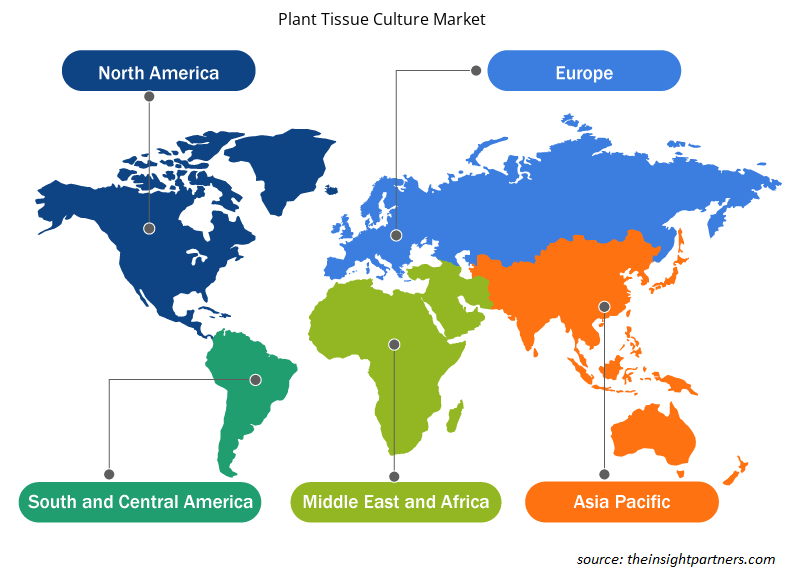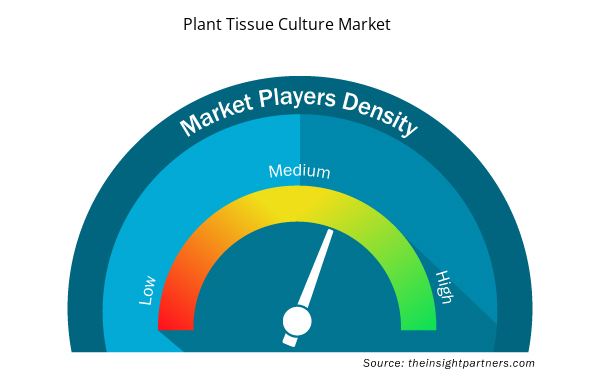[調査レポート] 植物組織培養市場は2021年に4億7,588万米ドルと評価され、2022年から2028年にかけて8.9%のCAGRで成長すると予想されています。CAGR of 8.9% from 2022 to 2028.
植物組織培養は、既知の組成の培養培地で、試験管内条件下で植物細胞、組織、または器官を成長させるために使用される一連の技術です。植物のクローンは、ミクロ増殖によって生成できます。組織培養により、病気のない高品質の植栽材料を生産できます。また、植物の迅速かつ均一な成長を促進します。遺伝子組み換え植物の需要の増加と花卉栽培の普及は、市場の成長を促進する主な要因です。ただし、組織培養手順の高コストが市場の進歩を妨げています。
植物組織培養市場は、技術、用途、材料、地理に基づいて分析されています。レポートでは、市場動向、技術の進歩、市場動向、主要な市場プレーヤーの競争環境分析など、さまざまなパラメータに重点を置いて、植物組織培養市場の洞察と詳細な分析を提供しています。
要件に合わせてレポートをカスタマイズする
このレポートの一部、国レベルの分析、Excelデータパックなど、あらゆるレポートを無料でカスタマイズできます。また、スタートアップや大学向けのお得なオファーや割引もご利用いただけます。
- このレポートの主要な市場動向を入手してください。この無料サンプルには、市場動向から見積もりや予測に至るまでのデータ分析が含まれます。
市場分析
遺伝子組み換え植物の需要増加が植物組織培養市場の成長を促進
トランスジェニック植物とは、遺伝子工学技術を使用して DNA を改変し、自然には発生しない新しい特性を植物に導入した植物です。これらのトランスジェニック植物は、通常、植物のゲノムに 1 つ以上の遺伝子を追加することにより、遺伝子構造を変更して実験室で遺伝子工学技術を使用して生成されます。トランスジェニック植物は、必要な栄養素を提供し、世界中の食糧需要に対応するために主に開発されています。
何百万人もの人々が栄養失調に苦しんでおり、これは発展途上国や後進国でより蔓延しています。世界保健機関(WHO)によると、2019年に約4億6,200万人が低体重でした。ユニセフによると、5歳未満の子供の死亡のほぼ半数が栄養失調に起因しています。さらに、2020年には、5歳未満の子供約4,540万人が衰弱し、そのうち約1,360万人が重度の衰弱でした。Global Change Data Labによると、2019年には世界人口の8.9%が栄養失調でした。栄養失調の人とは、カロリー摂取量が最低限のエネルギー必要量を下回っている人のことです。研究者は、これらのカロリー必要量を満たすために必要なカロリーを提供する遺伝子組み換え植物の開発に注力しています。遺伝子組み換え植物の需要は、植物組織培養市場の成長を促進しています。
タイプベースの洞察
タイプに基づいて、植物組織培養市場は、機器、培地と試薬、消耗品に分かれています。機器セグメントは2021年に最大の市場シェアを占めました。ただし、消耗品セグメントは予測期間中に最高のCAGRを記録すると予想されています。植物組織培養に使用される機器には、冷蔵庫、蒸留プラント、層流システム、計量天秤、インキュベーター、遠心分離機、滅菌器などがあります。
アプリケーションベースの洞察
用途に基づいて、植物組織培養市場は、植物研究、農業、林業および技術グレード、その他に分類されます。農業セグメントは2021年に市場で最大のシェアを占めました。ただし、植物研究セグメントは2022〜2028年に最高のCAGRを記録すると予想されています。
エンドユーザーベースの洞察
エンドユーザーに基づいて、植物組織培養市場は温室、フィールド、実験室に分類されます。フィールドセグメントは2021年に市場で最大のシェアを占めました。さらに、このセグメントの市場は2022年から2028年の間に9.2%のCAGRで成長すると予想されています。
多くの国で、COVID-19は国境を越えた人々の移動を制限し、ロックダウンは農業部門、特に季節的な労働需要のピークや労働集約型生産を特徴とする部門の労働力不足の一因となっています。たとえば、欧州連合(EU)内の移動禁止やシェンゲン協定国の閉鎖により、多くのヨーロッパ諸国で果物や野菜部門の労働力が大幅に減少しました。労働力不足は生産の損失や市場での品不足につながっています。COVID-19の緊急事態は、園芸製品の物流、流通、サプライチェーンに支障をきたしました。これにより、農産物のサプライチェーンが途絶えたために食糧不安が生じ、その結果、人口の大部分が手頃な価格で生鮮食品を入手することが困難になりました。このような前述の要因は、植物組織培養業界全体に深刻な影響を及ぼしました。
植物組織培養市場の地域別洞察
予測期間を通じて植物組織培養市場に影響を与える地域的な傾向と要因は、Insight Partners のアナリストによって徹底的に説明されています。このセクションでは、北米、ヨーロッパ、アジア太平洋、中東、アフリカ、南米、中米にわたる植物組織培養市場のセグメントと地理についても説明します。

- 植物組織培養市場の地域別データを入手
植物組織培養市場レポートの範囲
| レポート属性 | 詳細 |
|---|---|
| 2021年の市場規模 | 4億7,588万米ドル |
| 2028年までの市場規模 | 8億6,347万米ドル |
| 世界のCAGR(2021年~2028年) | 8.9% |
| 履歴データ | 2019-2020 |
| 予測期間 | 2022-2028 |
| 対象セグメント | タイプ別
|
| 対象地域と国 | 北米
|
| 市場リーダーと主要企業プロフィール |
|
植物組織培養市場のプレーヤー密度:ビジネスダイナミクスへの影響を理解する
植物組織培養市場は、消費者の嗜好の変化、技術の進歩、製品の利点に対する認識の高まりなどの要因により、エンドユーザーの需要が高まり、急速に成長しています。需要が高まるにつれて、企業は提供を拡大し、消費者のニーズを満たすために革新し、新たなトレンドを活用し、市場の成長をさらに促進しています。
市場プレーヤー密度とは、特定の市場または業界内で活動している企業または会社の分布を指します。これは、特定の市場スペースに、その規模または総市場価値と比較して、どれだけの競合相手 (市場プレーヤー) が存在するかを示します。
植物組織培養市場で事業を展開している主要企業は次のとおりです。
- セグラインターナショナル株式会社
- JRTナーセリーズ株式会社
- トーマス・サイエンティフィックLLC
- シグマアルドリッチ株式会社
- ハイメディアラボラトリーズ株式会社
免責事項:上記の企業は、特定の順序でランク付けされていません。

- 植物組織培養市場のトップキープレーヤーの概要を入手
2022年には、北米が植物組織培養市場で最大のシェアを占めました。この地域の市場成長は、組織培養の分野での研究開発活動の増加に起因しています。さらに、アジア太平洋地域は予測期間中に最速のCAGRを記録すると予想されています。中国、日本、インドは、この地域の植物組織培養市場への主要な貢献者です。APACでの市場成長は、組織培養ベースの研究を促進するための政府投資の増加、高度な技術の採用規模の拡大、組織培養研究室をサポートするインフラストラクチャの改善に起因しています。
地域別に見ると、植物組織培養市場は、北米(米国、カナダ、メキシコ)、欧州(英国、ドイツ、フランス、イタリア、スペイン、その他の欧州)、アジア太平洋(中国、日本、インド、韓国、オーストラリア、その他のアジア太平洋)、中東およびアフリカ(UAE、サウジアラビア、アフリカ、その他の中東およびアフリカ)、南米および中米(ブラジル、アルゼンチン、その他の南米および中米)に分類されます。
企業プロフィール
- セグラインターナショナル株式会社
- JRTナーセリーズ株式会社
- トーマス・サイエンティフィックLLC
- シグマアルドリッチ株式会社
- ハイメディアラボラトリーズ株式会社
- ケーソンラボ株式会社
- アルファラボラトリーズ株式会社
- ベクトン・ディキンソン
- AL-Rajhi組織培養ラボ
- アルワトバマリオンネットLLC
- 過去2年間の分析、基準年、CAGRによる予測(7年間)
- PEST分析とSWOT分析
- 市場規模価値/数量 - 世界、地域、国
- 業界と競争環境
- Excel データセット


- Dealer Management System Market
- Truck Refrigeration Market
- Print Management Software Market
- Military Rubber Tracks Market
- Airline Ancillary Services Market
- Investor ESG Software Market
- Educational Furniture Market
- Batter and Breader Premixes Market
- Aircraft MRO Market
- Authentication and Brand Protection Market

Report Coverage
Revenue forecast, Company Analysis, Industry landscape, Growth factors, and Trends

Segment Covered
This text is related
to segments covered.

Regional Scope
North America, Europe, Asia Pacific, Middle East & Africa, South & Central America

Country Scope
This text is related
to country scope.
よくある質問
Plant tissue culture is a set of techniques used to grow plant cells, tissues or organs under invitro conditions on a culture medium of known composition. Through micropropagation, clones of plants can be produced. Tissue culture is an important technology and enables production of high quality, disease-free planting material and the speedy production of uniform plants.
The increasing demand for transgenic plants, and growing demand for floriculture are the key driving factors behind the market development.
Based on type, instruments segment took the forefront lead in the worldwide market by accounting largest share in 2021 and is expected to continue to do so till the forecast period.
Global plant tissue culture market is segmented by region into North America, Europe, Asia Pacific, Middle East & Africa, and South & Central America. In North America, the U.S. is the largest market for plant tissue culture market. Growing investment for tissue culture techniques, well established scientific infrastructure and rising focus of market players are key factors responsible for market growth in the region.
Segra International Corp, JRT Nurseries Inc, Thomas Scientific LLC, Sigma-Aldrich Co LLC, HiMedia Laboratories Pvt Ltd, Caisson Labs Inc, Alpha Laboratories Ltd, Becton, Dickinson and Co., AL-Rajhi Tissue Culture Lab., Al Wathba Marionnet LLC. are among the leading companies operating in the plant tissue culture market.
Trends and growth analysis reports related to Life Sciences : READ MORE..
The List of Companies - Plant Tissue Culture Market
- Segra International Corp
- JRT Nurseries Inc
- Thomas Scientific LLC
- Sigma-Aldrich Co LLC
- HiMedia Laboratories Pvt Ltd
- Caisson Labs Inc
- Alpha Laboratories Ltd
- Becton, Dickinson and Co
- AL-Rajhi Tissue Culture Lab
- Al Wathba Marionnet LLC
The Insight Partners performs research in 4 major stages: Data Collection & Secondary Research, Primary Research, Data Analysis and Data Triangulation & Final Review.
- Data Collection and Secondary Research:
As a market research and consulting firm operating from a decade, we have published and advised several client across the globe. First step for any study will start with an assessment of currently available data and insights from existing reports. Further, historical and current market information is collected from Investor Presentations, Annual Reports, SEC Filings, etc., and other information related to company’s performance and market positioning are gathered from Paid Databases (Factiva, Hoovers, and Reuters) and various other publications available in public domain.
Several associations trade associates, technical forums, institutes, societies and organization are accessed to gain technical as well as market related insights through their publications such as research papers, blogs and press releases related to the studies are referred to get cues about the market. Further, white papers, journals, magazines, and other news articles published in last 3 years are scrutinized and analyzed to understand the current market trends.
- Primary Research:
The primarily interview analysis comprise of data obtained from industry participants interview and answers to survey questions gathered by in-house primary team.
For primary research, interviews are conducted with industry experts/CEOs/Marketing Managers/VPs/Subject Matter Experts from both demand and supply side to get a 360-degree view of the market. The primary team conducts several interviews based on the complexity of the markets to understand the various market trends and dynamics which makes research more credible and precise.
A typical research interview fulfils the following functions:
- Provides first-hand information on the market size, market trends, growth trends, competitive landscape, and outlook
- Validates and strengthens in-house secondary research findings
- Develops the analysis team’s expertise and market understanding
Primary research involves email interactions and telephone interviews for each market, category, segment, and sub-segment across geographies. The participants who typically take part in such a process include, but are not limited to:
- Industry participants: VPs, business development managers, market intelligence managers and national sales managers
- Outside experts: Valuation experts, research analysts and key opinion leaders specializing in the electronics and semiconductor industry.
Below is the breakup of our primary respondents by company, designation, and region:

Once we receive the confirmation from primary research sources or primary respondents, we finalize the base year market estimation and forecast the data as per the macroeconomic and microeconomic factors assessed during data collection.
- Data Analysis:
Once data is validated through both secondary as well as primary respondents, we finalize the market estimations by hypothesis formulation and factor analysis at regional and country level.
- Macro-Economic Factor Analysis:
We analyse macroeconomic indicators such the gross domestic product (GDP), increase in the demand for goods and services across industries, technological advancement, regional economic growth, governmental policies, the influence of COVID-19, PEST analysis, and other aspects. This analysis aids in setting benchmarks for various nations/regions and approximating market splits. Additionally, the general trend of the aforementioned components aid in determining the market's development possibilities.
- Country Level Data:
Various factors that are especially aligned to the country are taken into account to determine the market size for a certain area and country, including the presence of vendors, such as headquarters and offices, the country's GDP, demand patterns, and industry growth. To comprehend the market dynamics for the nation, a number of growth variables, inhibitors, application areas, and current market trends are researched. The aforementioned elements aid in determining the country's overall market's growth potential.
- Company Profile:
The “Table of Contents” is formulated by listing and analyzing more than 25 - 30 companies operating in the market ecosystem across geographies. However, we profile only 10 companies as a standard practice in our syndicate reports. These 10 companies comprise leading, emerging, and regional players. Nonetheless, our analysis is not restricted to the 10 listed companies, we also analyze other companies present in the market to develop a holistic view and understand the prevailing trends. The “Company Profiles” section in the report covers key facts, business description, products & services, financial information, SWOT analysis, and key developments. The financial information presented is extracted from the annual reports and official documents of the publicly listed companies. Upon collecting the information for the sections of respective companies, we verify them via various primary sources and then compile the data in respective company profiles. The company level information helps us in deriving the base number as well as in forecasting the market size.
- Developing Base Number:
Aggregation of sales statistics (2020-2022) and macro-economic factor, and other secondary and primary research insights are utilized to arrive at base number and related market shares for 2022. The data gaps are identified in this step and relevant market data is analyzed, collected from paid primary interviews or databases. On finalizing the base year market size, forecasts are developed on the basis of macro-economic, industry and market growth factors and company level analysis.
- Data Triangulation and Final Review:
The market findings and base year market size calculations are validated from supply as well as demand side. Demand side validations are based on macro-economic factor analysis and benchmarks for respective regions and countries. In case of supply side validations, revenues of major companies are estimated (in case not available) based on industry benchmark, approximate number of employees, product portfolio, and primary interviews revenues are gathered. Further revenue from target product/service segment is assessed to avoid overshooting of market statistics. In case of heavy deviations between supply and demand side values, all thes steps are repeated to achieve synchronization.
We follow an iterative model, wherein we share our research findings with Subject Matter Experts (SME’s) and Key Opinion Leaders (KOLs) until consensus view of the market is not formulated – this model negates any drastic deviation in the opinions of experts. Only validated and universally acceptable research findings are quoted in our reports.
We have important check points that we use to validate our research findings – which we call – data triangulation, where we validate the information, we generate from secondary sources with primary interviews and then we re-validate with our internal data bases and Subject matter experts. This comprehensive model enables us to deliver high quality, reliable data in shortest possible time.


 このレポートの無料サンプルを入手する
このレポートの無料サンプルを入手する